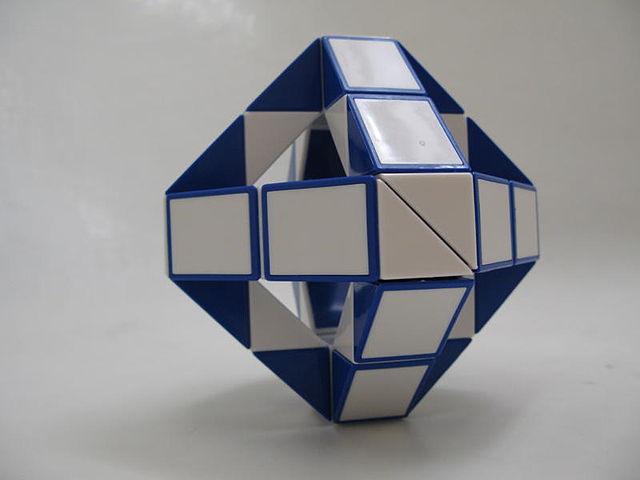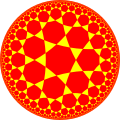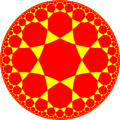Top Qs
Timeline
Chat
Perspective
Regular octahedron
Polyhedron with eight triangular faces From Wikipedia, the free encyclopedia
Remove ads
In geometry, a regular octahedron is a highly symmetrical type of octahedron (eight-sided polyhedron) with eight equilateral triangles as its faces, four of which meet at each vertex. It is a type of square bipyramid or triangular antiprism with equal-length edges. Regular octahedra occur in nature as crystal structures. Other types of octahedra also exist, with various amounts of symmetry.
A regular octahedron is the three-dimensional case of the more general concept of a cross-polytope.
Remove ads
Basics
Summarize
Perspective
The regular octahedron is one of the Platonic solids, a set of convex polyhedra whose faces are congruent regular polygons and the same number of faces meet at each vertex.[1] This ancient set of polyhedrons was named after Plato who, in his Timaeus dialogue, related these solids to classical elements, with the octahedron representing wind.[2] Following its attribution with nature by Plato, Johannes Kepler in his Harmonices Mundi sketched each of the Platonic solids.[2] In his Mysterium Cosmographicum, Kepler also proposed the Solar System by using the Platonic solids setting into another one and separating them with six spheres resembling the six planets. The ordered solids started from the innermost to the outermost: regular octahedron, regular icosahedron, regular dodecahedron, regular tetrahedron, and cube.[3]
Sketch of a regular octahedron by Johannes Kepler
Kepler's Platonic solid model of the Solar System
The dual of a regular octahedron is cube
A regular octahedron is the cross-polytope in 3-dimensional space. It can be oriented and scaled so that its axes align with Cartesian coordinate axes and its vertices have coordinates[4] Such an octahedron has edge length .
The regular octahedron's dual polyhedron is the cube, and they have the same three-dimensional symmetry groups, the octahedral symmetry .[5] Like its dual, the regular octahedron has three properties: any two faces, two vertices, and two edges are transformed by rotation and reflection under the symmetry orbit, such that the appearance remains unchanged; these are isohedral, isogonal, and isotoxal respectively. Hence, it is considered a regular polyhedron. Four triangles surround each vertex, so the regular octahedron is by vertex configuration or by Schläfli symbol.[6]
Remove ads
Metrical properties
Summarize
Perspective

The surface area of a regular octahedron can be ascertained by summing all of its eight equilateral triangles, whereas its volume is twice the volume of a square pyramid; if the edge length is ,[7] The radius of a circumscribed sphere (one that touches the octahedron at all vertices), the radius of an inscribed sphere (one that tangent to each of the octahedron's faces), and the radius of a midsphere (one that touches the middle of each edge), are:[8]
The dihedral angle of a regular octahedron between two adjacent triangular faces is 109.47°. This can be obtained from the dihedral angle of an equilateral square pyramid: its dihedral angle between two adjacent triangular faces is the dihedral angle of an equilateral square pyramid between two adjacent triangular faces, and its dihedral angle between two adjacent triangular faces on the edge in which two equilateral square pyramids are attached is twice the dihedral angle of an equilateral square pyramid between its triangular face and its square base.[9]
Remove ads
As a special case
Summarize
Perspective
The regular octahedron is one of the eight convex deltahedra, polyhedra whose faces are all equilateral triangles.[10]
A regular octahedron is a type of square bipyramid,[11] a composite polyhedron constructed by attaching two equilateral square pyramids base-to-base.[12][5] The dual polyhedron of a bipyramid in general is the prism, and vice versa; the regular octahedron's dual, the cube, is a type of square prism.[13]
The regular octahedron is a type of trigonal antiprism,[14] formed by taking a trigonal prism with equilateral triangle bases and rectangular lateral faces, and replacing the rectangles by alternating isosceles triangles. In the case of the regular octahedron, all of the resulting faces are congruent equilateral triangles.
The regular octahedron can also be considered a rectified tetrahedron, sometimes called a tetratetrahedron (by analogy to the cuboctahedron and icosidodecahedron); if alternate faces are considered to have different types (e.g. different colors or orientations), the octahedron can be considered a type of quasiregular polyhedron, a polyhedron in which two different polygonal faces are alternating and meet at a vertex.[15] It exists in a sequence of symmetries of quasiregular polyhedra and tilings with vertex configurations (3.n)2, progressing from tilings of the sphere to the Euclidean plane and into the hyperbolic plane. With orbifold notation symmetry of *n32 all of these tilings are Wythoff constructions within a fundamental domain of symmetry, with generator points at the right angle corner of the domain.[16][17]
Graph
Summarize
Perspective

The skeleton of a regular octahedron can be represented as a graph according to Steinitz's theorem, provided the graph is planar—its edges of a graph are connected to every vertex without crossing other edges—and 3-connected graph—its edges remain connected whenever two of more three vertices of a graph are removed.[18][19] Its graph called the octahedral graph, a Platonic graph.[1]
The octahedral graph can be considered as complete tripartite graph , a graph partitioned into three independent sets, each consisting of two opposite vertices.[20] More generally, it is a Turán graph .
The octahedral graph is 4-connected, meaning that it takes the removal of four vertices to disconnect the remaining vertices. It is one of only four 4-connected simplicial well-covered polyhedra, meaning that all of the maximal independent sets of its vertices have the same size. The other three polyhedra with this property are the pentagonal dipyramid, the snub disphenoid, and an irregular polyhedron with 12 vertices and 20 triangular faces.[21]
Remove ads
Other related figures
Summarize
Perspective
One can also divide the edges of an octahedron in the ratio of the golden mean to define the vertices of a regular icosahedron. This is done by first placing vectors along the octahedron's edges such that each face is bounded by a cycle, then similarly partitioning each edge into the golden mean along the direction of its vector. Five octahedra define any given icosahedron in this fashion, and together they define a regular compound. A regular icosahedron produced this way is called a snub octahedron.[22]
The regular octahedron represents the central intersection of two tetrahedra
The truncated octahedron by removing the vertices of a regular octahedron
The triakis octahedron by attaching triangular pyramids on each face
The interior of the compound of two dual tetrahedra is an octahedron, and this compound—called the stella octangula—is its first and only stellation.[23] Correspondingly, a regular octahedron is the result of cutting off from a regular tetrahedron, four regular tetrahedra of half the linear size (i.e. rectifying the tetrahedron). The vertices of the octahedron lie at the midpoints of the edges of the tetrahedron, and in this sense, it relates to the tetrahedron in the same way that the cuboctahedron and icosidodecahedron relate to the other Platonic solids.
Several constructions of polyhedra commence from the regular octahedron. The truncated octahedron is an Archimedean solid, constructed by removing all of the regular octahedron's vertices, resulting in six squares and eight hexagons, leaving out six square pyramids.[24] The triakis octahedron is a Catalan solid, the Kleetope of a regular octahedron, by attaching triangular pyramids onto its faces, topologically similar to the stellated octahedron.[25] The uniform tetrahemihexahedron is a tetrahedral symmetry faceting of the regular octahedron, sharing edge and vertex arrangement. It has four of the triangular faces and three central squares.[26]
Tetrahedral-octahedral honeycomb by regular octahedra and tetrahedra
Rectified cubic honeycomb by regular octahedra and cuboctahedra
Regular octahedra and regular tetrahedra can be alternated to form a vertex, edge, and face-uniform tessellation of space. The regular octahedra can also tessellate alternately with cuboctahedra. These honeycombs are named tetrahedral-octahedral and rectified cubic honeycomb.[27] R. Buckminster Fuller in the 1950s applied these alternating polyhedra as a space frame, which developed the strongest building structure for resisting cantilever stresses.[28]
A regular octahedron is a 3-ball in the Manhattan (ℓ1) metric.
Remove ads
Characteristic orthoscheme
Summarize
Perspective
Like all regular convex polytopes, the octahedron can be dissected into an integral number of disjoint orthoschemes, all of the same shape characteristic of the polytope. A polytope's characteristic orthoscheme is a fundamental property because the polytope is generated by reflections in the facets of its orthoscheme. The orthoscheme occurs in two chiral forms which are mirror images of each other. The characteristic orthoscheme of a regular polyhedron is a quadrirectangular irregular tetrahedron.
The faces of the octahedron's characteristic tetrahedron lie in the octahedron's mirror planes of symmetry. The octahedron is unique among the Platonic solids in having an even number of faces meeting at each vertex. Consequently, it is the only member of that group to possess, among its mirror planes, some that do not pass through any of its faces. The octahedron's symmetry group is denoted B3. The octahedron and its dual polytope, the cube, have the same symmetry group but different characteristic tetrahedra.
The characteristic tetrahedron of the regular octahedron can be found by a canonical dissection[29] of the regular octahedron ![]()
![]()
![]()
![]()
![]() which subdivides it into 48 of these characteristic orthoschemes
which subdivides it into 48 of these characteristic orthoschemes ![]()
![]()
![]()
![]()
![]() surrounding the octahedron's center. Three left-handed orthoschemes and three right-handed orthoschemes meet in each of the octahedron's eight faces, the six orthoschemes collectively forming a trirectangular tetrahedron: a triangular pyramid with the octahedron face as its equilateral base, and its cube-cornered apex at the center of the octahedron.[30]
surrounding the octahedron's center. Three left-handed orthoschemes and three right-handed orthoschemes meet in each of the octahedron's eight faces, the six orthoschemes collectively forming a trirectangular tetrahedron: a triangular pyramid with the octahedron face as its equilateral base, and its cube-cornered apex at the center of the octahedron.[30]
If the octahedron has edge length 𝒍 = 2, its characteristic tetrahedron's six edges have lengths , , around its exterior right-triangle face (the edges opposite the characteristic angles 𝟀, 𝝉, 𝟁),[a] plus , , (edges that are the characteristic radii of the octahedron). The 3-edge path along orthogonal edges of the orthoscheme is , , , first from an octahedron vertex to an octahedron edge center, then turning 90° to an octahedron face center, then turning 90° to the octahedron center. The orthoscheme has four dissimilar right triangle faces. The exterior face is a 90-60-30 triangle, which is one-sixth of an octahedron face. The three faces interior to the octahedron are: a 45-90-45 triangle with edges , , , a right triangle with edges , , , and a right triangle with edges , , .
Remove ads
Other apppearances
Summarize
Perspective
In nature

- Natural crystals of diamond, alum or fluorite are commonly octahedral, as the space-filling tetrahedral-octahedral honeycomb.
- The plates of kamacite alloy in octahedrite meteorites are arranged paralleling the eight faces of an octahedron.
- Many metal ions coordinate six ligands in an octahedral or distorted octahedral configuration.
- Widmanstätten patterns in nickel-iron crystals
In art and culture

- Especially in roleplaying games, this solid is known as a "d8", one of the more common polyhedral dice.[32]
- If each edge of an octahedron is replaced by a one-ohm resistor, the resistance between opposite vertices is 1/2 ohm, and that between adjacent vertices 5/12 ohm.[33]
- The hexany is the octahedron's orthogonal projection. Six musical notes can be arranged on the vertices of an octahedron in such a way that each edge represents a consonant dyad and each face represents a consonant triad.[34]
Other related polyhedra
Truncation of two opposite vertices results in a square bifrustum.
The octahedron can be generated as the case of a 3D superellipsoid with all exponent values set to 1.
Remove ads
See also
Notes
- (Coxeter 1973) uses the Greek letter 𝝓 (phi) to represent one of the three characteristic angles 𝟀, 𝝓, 𝟁 of a regular polytope. Because 𝝓 is commonly used to represent the golden ratio constant ≈ 1.618, for which Coxeter uses 𝝉 (tau), we reverse Coxeter's conventions and use 𝝉 to represent the characteristic angle.
References
External links
Wikiwand - on
Seamless Wikipedia browsing. On steroids.
Remove ads

































 ,
,  ...
...















